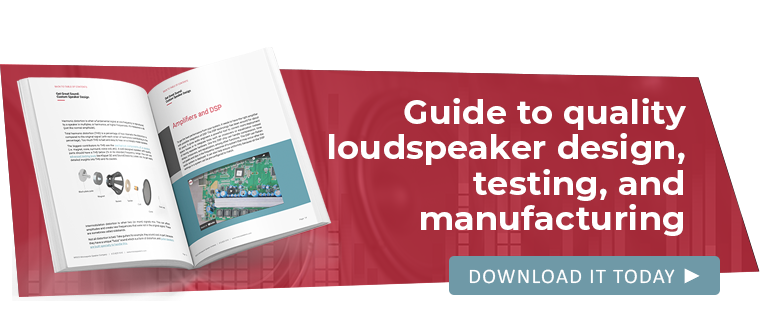OEM Speaker Design: Building the Driver [VIDEO]
The speaker driver, also known as a transducer, is responsible for converting electrical energy (audio signals) into mechanical energy (sound waves). It is imperative that the driver be assembled with the right high-quality components and materials in order to get great sound and long life out of your speaker.
You can see a more in-depth explanation of speaker materials in the previous video of MISCO’s series on “Designing & Building a Loudspeaker.” The series shows the component choices made in constructing one specific 5.25” subwoofer, but the principles apply broadly to almost any speaker project.
Designing and Building a Loudspeaker Video Series
The idea behind this video series is to give customers a close-up look at what goes into designing, building, and testing a speaker. If you missed the previous videos, you can find them all in this playlist.
Materials definitely matter in loudspeaker quality, but precise construction is equally important. Watch the video or continue reading for a breakdown of how MISCO engineers piece together drivers with precision, every time.
Resource: Speaker Specs 101
Building the Driver
Construction starts at the basket (frame), which is what all other parts of the speaker are attached to. It is first attached to the front plate of the speaker, and a silicone gasket adhesive is applied, not to bond the two elements together, but to prevent metal-on-metal vibrations that would otherwise interfere with the sound. Once the silicone barrier is applied, the front plate is staked to the basket using the four nubs on the front plate.
The next step is assembling the magnetic motor, first by applying a primer to the T-yoke, which will accelerate the adhesive bond between the magnet and the T-yoke. The adhesive used in this example is an anaerobic structural acrylic that cures quickly (in about 30 seconds) and forms a very durable bond.
The magnet is set in place and a centering bushing is quickly applied to keep the T-yoke and magnet equidistant all the way around while they adhere together. The magnet is not yet charged and will be magnetized in the final steps of this operation.
Once the adhesive is fully cured, the centering bushing is removed, and the same primer/adhesive combo is applied to the top of the magnet where it will be attached to the basket. Another precise centering bushing is temporarily placed to keep the T-yoke pole in line with the basket front plate while it dries.
When the magnet assembly adhesive is cured and the bushing is removed, next up is the voice coil. The voice coil is placed over a precise plastic centering gauge to ensure that the coil is where it needs to be in the concentric magnetic field. This sets the windings properly relative to the magnetic field.
Next, the spider is anchored to the basket using a soft, water-soluble adhesive that bonds to both the painted steel and the treated cloth equally well. The cone, made of paper with a polyether foam edge, is then attached to the terminal strip mounting of the basket using the same water-soluble adhesive. The cone is lined up so that the eyelets on it line up with the voice coil leads.
A second bead of the same adhesive is applied to the top of the cone surround that binds the gasket to the cone. Once the gasket is in place, the cone is secured to the voice coil directly using a high-temperature cyanoacrylate adhesive that is activated to accelerate the curing time. Like all adhesives that are applied to a speaker, the correct location and the correct amount is critical for a speaker to operate properly.
The next step is installing the tinsel wire into the speaker and connecting the wire between the terminal strip on the basket and the eyelets on the cone. The tinsel wire is thread through the eyelets on the cone and through a hole in the terminal strip.
The tinsel wire is then soldered to the terminal strip. This is a delicate step because the wire contains a Kevlar or cotton thread; the heat must be high enough for the solder to flow evenly, but not so hot that it burns the thread or fiber.
Next, the voice coil wire is wrapped around the eyelets of the cone to make a mechanical connection between the voice coil and the tinsel leads. The tinsel leads and voice coil wires are soldered at the cone eyelet. Again, this requires precision and ensuring enough heat for the solder to flow, but not too much so that it burns either the tinsel lead or the paper cone. The last part of this step is trimming off the excess tinsel lead, both from the terminal strip and also on top of the cone and the cone eyelets.
The voice coil centering gauge is then removed and a soft, flexible vinyl adhesive is applied over the voice coil wires and eyelet areas. This prevents the wires from buzzing and also makes sure they're supported with adhesive to maintain strength during operation.
The last part to install is the dust cap. The same vinyl adhesive is applied to the cone and the dust cap is secured in place overtop of the voice coil to keep any debris out and ensure a long operational life.
With that, the speaker assembly is finished! Once all of the adhesives are allowed to fully cure, the driver is ready for magnetization and acoustical testing. It is put into a capacitor discharge magnetizer that quickly charges the magnet. With that, it is ready for final testing.
The next video in the series expands on the rigorous testing process that MISCO conducts to ensure all of the different specifications are met from both the client’s perspective and the engineering perspective. If you have any questions about our process, please reach out to our team.

